Design Operations Guide
Set Expectations
Leadership and Stakeholders
Setting expectations with leadership and stakeholders is one of the hardest parts of the design phase. Since you are making something that is not yet known, estimating time and personnel need is by definition difficult. On the other hand, the authors of this guide know that design teams will need to be able to make some sort of time and personnel estimation for supervisors, partners, and others in order to get the go-ahead to start the design phase. You can use the illustration of the design phase work and the accompanying framework in this section to help you envision the work that occurs in the design phase and to aid your planning.
Click to enlarge the above image
Framework: First Draft Project Plan
Each design phase differs depending on the nature of the product, service, or system, the bandwidth and expertise of the team, access to the participants and stakeholders, and the scope of the project itself. If necessary, create a rough map of each of these parameters to understand your timeline.
Get started on building a timeline for your project by using the timeline framework in this section. To fill out this framework, you will need to map answers to the following questions:
- Do you have ready access to the stakeholders and participants, or is access less well defined?
- What is the nature of your opportunity spaces? Are they big and conceptual? Or smaller and tactical?
- Do you have a team with many conceptual skills and emotional intelligence? Or is your team heavier on technical knowledge?
The project plan you map at this stage should not be understood as perfect or fixed for your project; it is simply a best estimation of how much time your project will need, based on what you know at this early stage. You can use this estimation so you can set expectations with your supervisor, stakeholders, and teammates for the project term. Hint from a design professional: A good rule for estimating project timelines is to take the total amount of time you think the project will take and then add 20% more time to it. This extra padding allows you to absorb the inevitable bumps in the road that come along with creating new products, services, and systems in our complex, multi-faceting work environment.

